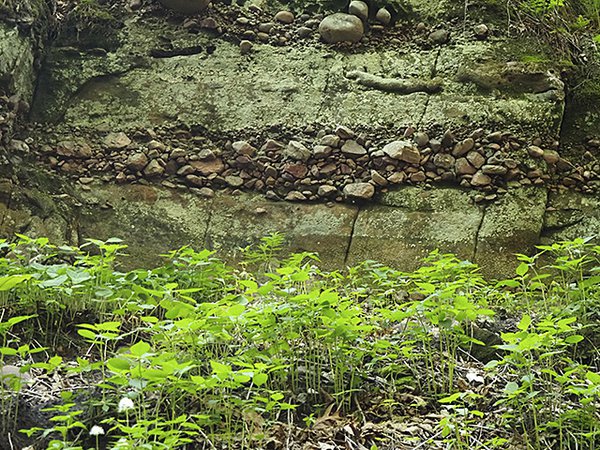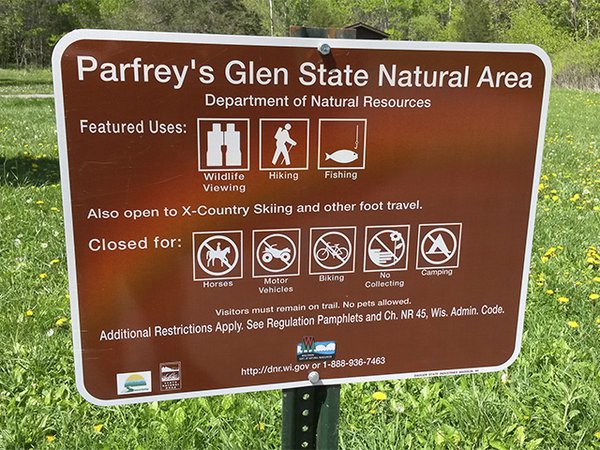Wrote this for the Isthmus, June 2023 issue.
Wisconsin’s natural diversity was not lost on many of the early conservationists, such as Aldo Leopold, John Curtis, Albert Fuller and Norman Fassett, a UW-Madison professor of botany and taxonomy. They all were involved in the creation of the Wisconsin State Natural Areas Program, part of the Department of Natural Resources, but Fassett was the kingpin. It was his work that designated Parfrey’s Glen as State Natural Area Number One. It cemented in place the system that would create 687 State Natural Areas over the following six decades.
These run from less than an acre to more than 7,500 acres, but size, in this case, doesn’t matter. It’s about the uniqueness of the flora, fauna, geology, and historical nature of the area. There used to be a sign giving credit to Dr. Fassett, but it’s gone, replaced with a bronze plaque fastened to a boulder. No mention of Norm.
So let’s talk about Number One.
Parfrey’s Gorge, or glen, is one of the prettiest bits of scenery in the Baraboo Valley — a tiny gem. Imagine two green and brown curtains 100 feet high, parting the sandstone and higher formations of this section of the Baraboo Bluffs, swinging open the doors about 75 feet, and revealing a vista of a third of a mile into a valley of the highlands, through which comes leaping down a foaming stream, lively, beautiful — and powerful for turning the wheels of industry in pioneer times.
-A Standard History of Sauk County, Wisconsin by Harry Ellsworth Cole, 1918
Over a century later, Cole’s observations are still accurate. The stone walls are covered with ferns and other moisture-loving plants, including some threatened and endangered species. There are rare species besides plants: the stream has an endangered diving beetle and caddisfly, all in this short stretch. The strata in the lower walls are complex and varied, laid down over 10 million years, at the rate of a meter every million years; incomprehensibly slow, a millimeter every 10,000 years. Most interesting to me are the conglomerates contained in some of the Cambrian strata, with embedded pebbles from as small as a lentil to as big as a bowling ball.
I knew Parfrey’s Glen’s beauty from my many visits there, but I didn’t know how unique it was. Digging into some geology websites, I learned that half a billion years ago, Parfrey’s Glen was under water. No big surprise: The entire Midwest was under a shallow, warm sea, full of invertebrates, such as our state fossil, the trilobite. The deposits gradually compressed into sandstone with a matrix of conglomerate stones. Glaciers didn’t have as much of an impact due to the hard quartzite cap, and the glen was formed by water, not ice. Still, it took awhile.
I went up to the glen in late May, just to see some ferns, moss and lichens, to inhale the ineffable fragrance that emanates when plants grow on sandstone walls. Seepage from springs keep the walls damp and cool, and even in warmer temperatures, we usually pack a light fleece sweater as the temp dropped 10 degrees once we entered the glen. All that rock makes for an enormous heat sink, and the moisture makes the entire glen an evaporative cooler. Remember that in August.

Until a decade ago, there was a boardwalk built by the DNR to make access easier. Flash floods have roared through the gulch numerous times in modern history, the last one ripping out the entire boardwalk; quite a feat, given how sturdy it was. Now visitors are required to ford the creek bed, taking slippery side trails up to the waterfall that indicates the end of the trail. It may keep some folks from walking past the sign indicating the end of a maintained trail. I’m okay with that. I like walking in the cool water, even if my toes go numb.
Although access has been made more difficult by the lack of a boardwalk, there were still signs of prohibited activities. No pets, food or drink are allowed in the SNA, but I picked up granola bar wrappers, and ran into two well-behaved but still forbidden dogs. Some visitors had scratched their names into the soft sandstone. I found evidence that A. loves G. But A. doesn’t understand the N in SNA.
I tiptoed through the stream, trying my best to step on flat stones where I wouldn’t stir up any sediment. I was rewarded with a glimpse of a beautiful brook trout about five inches long, stationary in an eddy behind a rock, just downstream from a mini cascade that aerated the water with a music I haven’t heard since freeze-up last winter. My wife commented that I had been humming a lot. She said I do that when I’m happy.
Even more important than recreational uses, the true value of a State Natural Area is its ecological value. Just a few miles south of Madison is the Badfish Creek Wet Prairie and Spring Seeps, State Natural Area 681, designated in 2016. I had never heard of a wet prairie, but since my favorite launching site for paddling the Badfish Creek is just a few hundred yards away, I investigated. Wet prairies have an extraordinarily high water table, just a foot or less below the surface. They are extremely rare, as many were drained and plowed, and there are fewer than a thousand acres remaining statewide. The Badfish Creek SNA contains 10% of our state’s total and is considered one of the top examples.
State Natural Areas can also surprise you. In 2021, Department of Natural Resources scientist Ryan O’Connor was surveying a small SNA in north central Wisconsin, and found an endangered species: a green violet. That was something in and of itself, but then he spotted a patch of them. Last seen in Grant County in 1958, this beautiful plant with subtle green flowers was presumed extinct in Wisconsin. O’Connor ran across this patch during one of his many surveys of SNAs, and it was, in his words, “a holy grail-type find.”

Hybanthus concolor is the only species in its genus of the violet family (Violaceae), and it bears little resemblance to the squat and colorful little wood violets you see all over the place. It can grow up to three feet tall, and the flowers sit close to the stem, similar to lilies of the valley, hanging like a small green bell. Once pollinated, the petals fall off, the ovary swells and opens up, exposing seeds covered with a fat and protein-rich coating called elaiosome. Irresistible to ants, they harvest the seeds, take them back to their colonies, eat the elaiosome and leave the seeds to germinate.
The location of these rare violets is a well-kept secret. I got a hold of O’Connell, and while he couldn’t have been more kind, he was unable to disclose the SNA where he found them. The DNR doesn’t want it known to the general public, for obvious reasons. Well-meaning visitors might love the violets to death, and a bad player may poach plants for their garden.
There are almost 700 SNAs in Wisconsin, and most of them have some sort of rare, threatened flora or fauna, like the Karner blue butterfly, a species of concern, or even threatened snails, like the whimsically-named cherrystone drop or wing snaggletooth. There are 24 pages of extinct, endangered, threatened or of concern species in Wisconsin. State Natural Areas are part of what keeps hope alive.
